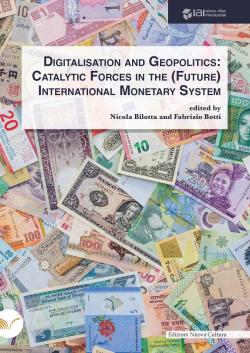Digitalisation and Geopolitics: Catalytic Forces in the (Future) International Monetary System
La recente trasformazione della finanza in arma contro la Russia potrebbe accelerare l’ambizione e le azioni volte a ripensare la globalizzazione finanziaria, e questo allo scopo di ridurre la dipendenza globale da valute e infrastrutture di pagamento a guida occidentale. Ma, storicamente, le trasformazioni nel sistema monetario internazionale sono lente a concretizzarsi. L’inerzia e gli attriti sono forze che tendono a consolidare l’unipolarità del sistema ma, in un contesto di crescente politicizzazione del denaro, il processo di digitalizzazione finanziaria può rappresentare una cruciale forza di cambiamento nella spinta al diversificare. Nessun altro contendente può sfidare l’attuale sistema del dollaro dominato dagli Stati Uniti nel breve e medio termine, ma è fondamentale riflettere strategicamente sulle implicazioni a lungo termine di una possibile erosione della leadership occidentale nel sistema monetario globale. Questo volume si concentra su una questione chiave, ossia se le recenti tensioni geopolitiche e gli sconvolgimenti economici possano essere un catalizzatore per la trasformazione dell’attuale sistema monetario internazionale.
-
Dati bibliografici
Roma, Nuova Cultura, marzo 2023, 166 p. : ill. -
Numero
10 -
ISBN/ISSN/DOI:
978-88-3365-572-7
Contributors, p. 7-10
List of abbreviations, p. 11-13
Introduction, by Nicola Bilotta and Fabrizio Botti, p. 15-17
1. The Future of the International Monetary System: Geopolitics and Technology, by Luca Fantacci and Lucio Gobbi, p. 19-47
1. Today: The current state of the international monetary system
1.1 Official use – Store of value
1.2 Official use – Means of payment
1.3 Official use – Unit of account
1.4 Private use – Store of value
1.5 Private use – Means of payment
1.6 Private use – Unit of account
2. Yesterday: How the dollar became the world’s currency
2.1 The Bretton Woods regime of capital controls
2.2 Fiat money and the oil shocks
2.3 Financial liberalisation
3. Tomorrow: Scenarios for the international monetary system
3.1 Technological challenge: The rise of cryptocurrencies
3.2 Geopolitical challenge: The impact of economic warfare
References
2. CBDCs and the US Dollar: Motivations and Emerging Issues, by Ananya Kumar, p. 49-64
1. What is a CBDC?
2. Motivations for developing CBDCs
3. Cybersecurity and privacy concerns
3.1 A cross-border use-case for CBDCs
4. The digital dollar and US leadership
References
3. Going Global: The Political Ambition and Economic Reality of the (Digital) Euro, by Nicola Bilotta and Erwin Voloder, p. 65-92
1. Digitalisation of payments: The geostrategic implications for the EU domestic market
2. The digital euro: The implications of its internationalisation
3. Digital-currency competition and norm entrepreneurialism
Conclusion
References
4. Different Futures for a Digitalised Global Financial System: How Can Europe Deal with Politicisation and Weaponisation?, by Maaike Okano-Heijmans and Brigitte Dekker, p. 93-111
1. Uncertainties and different futures
1.1 Concentration versus diversification: The rise of new players in digital finance
1.2 Harmonisation versus fragmentation: Regulatory pathways
2. Mapping the future of the digital financial system: Four scenarios
2.1 Harmonisation x concentration | Regulated Big Tech banking
2.2 Harmonisation x diversification | Interoperable financial ecosystems
2.3 Fragmentation x concentration | Big Tech banking goes local
2.4 Fragmentation x diversification | The decentralised crypto-economy
3. Towards politicisation and weaponisation?
Conclusion
References
5. China’s e-CNY as a Geopolitical Weapon: A New Era of Minilateralism in Asia’s Digital Economy, by Kai von Carnap, p. 113-140
1. Conditioning trade
1.1 Facilitating regional trade and investment: The renminbi’s future role
1.2 “Programmability” conditions and controls, spending and the use of e-CNY units
2. Three strategic themes for promoting foreign use
2.1 Three themes for promoting the e-CNY abroad
2.2 Domestic issues remain key drivers of the e-CNY’s development
3. Promoting the e-CNY through regional minilateralism
3.1 The main obstacle: Legal provisions for cross-border use of the e-CNY
3.2 Cross-border e-CNY pilots have been targeting different asymmetric minilateral arrangements
4. Outlook
4.1 Fragmentation of payment networks
References
6. Golden Parachute: Financial Sanctions and Russia’s Gold Reserves, by Daniel McDowell, p. 141-157
1. Sanctions and the growth of Russian gold reserves
2. Explaining Russia’s thirst for gold
3. Russian gold after the 2022 invasion of Ukraine
3.1 Gold sales in non-traditional markets
3.2 The crashing ruble, capital controls, and gold
Conclusions
References
Conclusion, by Nicola Bilotta, p. 159-164




